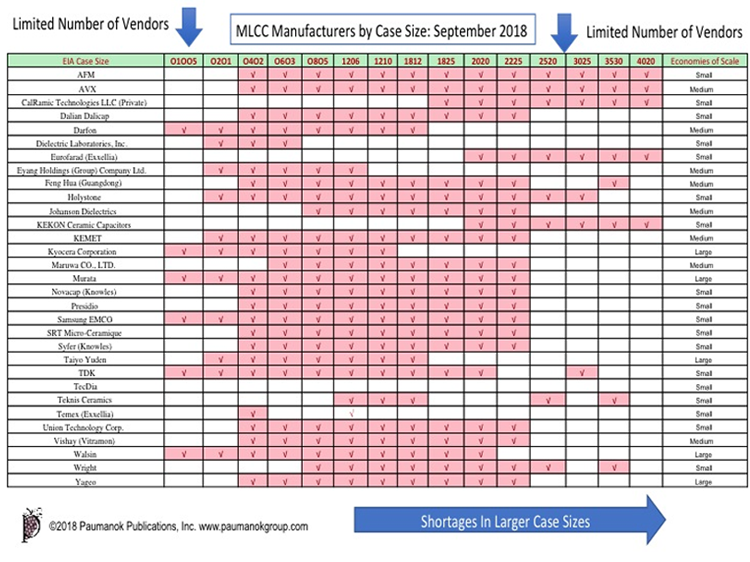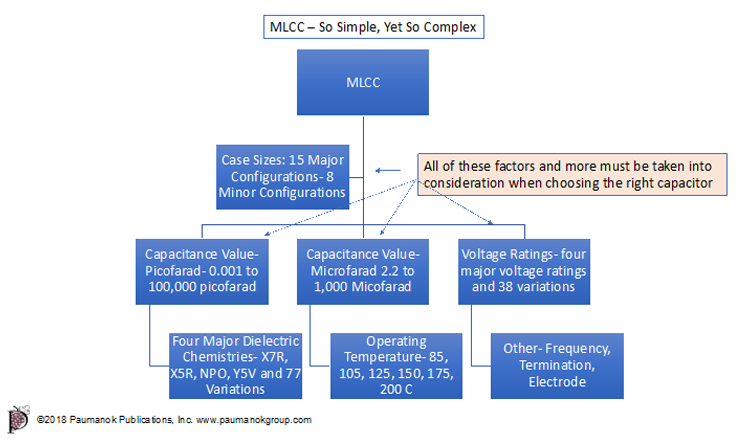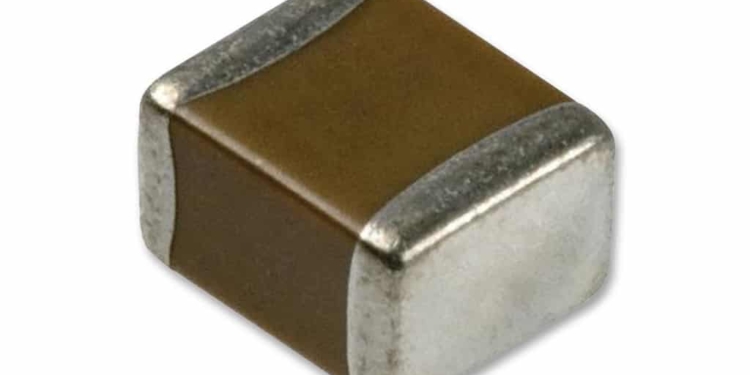Source: TTI Market Eye article
by Dennis M. Zogbi
Over the past 30 years the multilayered ceramic chip capacitor (MLCC) has increased its worldwide production capacity from hundreds of millions of pieces to trillions of pieces. At specific intervals in the growth of the market there have been strategic shifts in global output by physical MLCC case size, with the larger trend of portability in the end product markets driving the tooling of MLCC production parts and MLCC pick and place equipment. Today in 2018 the market is again faced with a transitional period, with many customers scrambling to understand and address shortfalls in case size.
Trend Analysis by Case Size
The overall trend analysis with respect to production by case size of MLCC over time shows that MLCC movement toward smaller case sizes has been a constant, and largely tied to the rise in production of wireless handsets and the respective increases in overall features and functionality. In MLCC the global investment in ceramic dielectric materials and metal electrode powders has created a materials matching system that is both cost effective and enabling in terms of maximizing capacitance in increasingly smaller case sizes. This trend is a continual process and yet many customers are loathe to change successful reference designs because the output is unfamiliar to the design engineer.
The graph below illustrates how production of MLCC began to move continually downward in case size to accommodate the increased functionality of wireless handsets; and notebook computers; while supplying new ultra-small initiatives in portable electronics markets (MP3 player, digital camera, game console, keyless entry, medical implants, etc.). However, the graph also shows an increase in production of the larger case size MLCC in the 1206 and the 1210 case size MLCC. This is the result of innovations in higher capacitance materials and stacking processes that enabled higher capacitance MLCC to compete against tantalum chip capacitors. This trend continues with top vendors suggesting a 330 µF and a 470 µF and 1000 µF MLCC are future company goals and the subject of a significant amount of the budgeted 2019 FY R&D spending. However, the ability to profitably stack higher capacitance MLCC in smaller case sizes is leaving the need for larger case size production unnecessary. This leaves the capacity to produce large case size MLCC for legacy products in automotive, power supplies, oil and gas electronics and telecom infrastructure increasingly small and customers scrambling to get alternative suppliers.
Summary Graph 1: Global Production Volume for MLCC By Case Size: 1991-2017 As a percentage of total units produced in the designated Year.
Global Consumption Value for MLCC By Case Size: 1991-2017

Miniaturization: Driven by and for the Market
The smaller case size passive components in the 0402, 0201 and the new 01005 case sizes have been developed for the portable telecommunications and digital camera market segments. The availability of ultra-small case size passive components have also helped to enable increasingly smaller portable electronic devices to be produced in other market segments as well – handheld video games, video and still cameras, portable MP3 players, notebook computers and PDAs, to name a few multi-billion product lines that have benefited from the development of ultra-small case size passive electronic components.
Over the past ten years the leading edge of demand for extremely small capacitors and resistors (01005) will continue to be in the production of ultra-small modules for power and antenna functions in wireless handsets. Demand for ultra-small passive components, especially in the 0201 and the 01005 cases will continue to grow to meet demand from the blossoming modules markets for existing applications in wireless handsets; and for new applications in portable consumer equipment and devices.
The theory behind the use of modules is that they increase the throughput of manufacturing for the portable electronic device producer, which is critical, especially in handsets, where the time from design to market is becoming increasingly narrow.
A Separate Outlook
Global production of multilayered ceramic chip capacitors (MLCC) is moving in two separate directions when it comes to the physical case size (footprint) of the finished capacitor. This trend should continue as new and increasingly higher capacitance MLCC (330, 470 µF) will be developed during this time period in the larger MLCC case sizes. Also, continued growth in demand for the 0201 and the 01005 case size MLCC is anticipated as handset manufacturers tend to shift their footprint to the smallest passive component parts available every five years. Thus growth for the 01005 and the 0201 MLCC is assured based upon past demand curves in what had been leading edge in ultra-small components in the past. A good example would be a teardown of a handset built in 1995, 2000 and 2006; and see the complete transition to the smallest MLCC and chip resistors available from the market at each benchmarked time interval).
The following graph (Summary Graph 1) illustrates how since 1991, (when Paumanok began tracking case size production data) the trend has been to make the MLCC continually smaller (This was enabled by advances in ceramic and metal powder technology, and the ability to apply that technology successfully in the form of dielectric layers and electrode inks). This has resulted in the movement over time toward continually smaller case size MLCC; beginning with the transition from the 0805 to the 0603; and then from 0603 to 0402.
In 2018 the movement continues to be toward the 0201; and then toward the ultra-small 01005 (see summary Graph 1). Modules consumed in wireless handsets for power amplifier functions continue to drive demand for the 0201 and 01005 ceramic chip capacitors. Growth in demand for modules, primarily those manufactured using traditional FR4 processes for the power amplifier function; and those manufactured using LTCC processes for antenna modules dominate ultra-small case size passive component consumption.
As a result of high capacitance technology, which involves increasing available surface area (capacitance is equivalent to the available surface area) through stacking multiple layers of ceramic dielectric and nickel internal electrode; there has also been an increase in production of the larger case size MLCC as well. Thus in the instance of MLCC, the higher capacitance products typically were produced in case sizes 1206 and larger; and thus, there has been growth in the larger case size MLCC. However much of this capacity has been repurposed for high cap MLCC leaving gaps in high temperature, high voltage and high frequency MLCC.
Research and development spending at the top MLCC manufacturers continues to be on improving the capacitance range in X5R and X7R dielectrics; and to make more of the ultra-small 0201 and 01005 MLCC in NPO dielectrics for high frequency communications circuits. What we also see is a complete lack of support for MLCC in non growth end markets such as engine control units for internal combustion engines and fuel based aircraft, as well as a loss of support for, TV sets, servers, desktop computers and industrial grade and infrastructure MLCC.
Tier-To-Tier Strategy in MLCC
The following chart should be used as a guide for the reader to begin searching for alternative vendors of MLCC by case size. The reader will note that the vendors of ultra-small and ultra-large MLCC chips are limited. There are also economies of scale factors at play here (i.e. a small vendor of MLCC cannot handle large orders) however, for the smaller MLCC manufacturer facing shortages based on case size the chart below is a good reference tool brought to you by MarketEYE.
Summary Graph 2: MLCC Vendors by Case Size As a percentage of total units produced in the designated Year

Source: Paumanok – remember that each vendor differs with respect to what it can fit in each case size when it comes to capacitance, voltage and performance.
Other Considerations When Choosing a MLCC
In addition to the numerous case sizes available in MLCC, which include 15 major variations and 8 minor variations (See Summary Graph 3), the available capacitance value in each case size will differ amongst manufacturers. Some vendors will sell picofarad based MLCC in the same case size as a microfarad MLCC. At an even more granular level of choice when it comes to MLCC is the voltage rating. While most MLCC are sold at 50 Vdc ratings (and then de-rated), the actual number of voltage ratings is four major voltages and 38 variations. Additionally, the capacitance chemistry is important because it determines how the capacitor will perform in the circuit, especially when exposed to temperature, therefore there are four major ceramic chemistries and (a mind numbing 77 variations. Operating temperature is also a consideration with most products operating at 85 degrees C with some professional electronics requiring 105 C operation of the MLCC. Automotive and defense electronics require operating temperature at 125 C and above. Other variations in choosing and MLCC includes the type of terminations (i.e. flexible termination versus metal solder)
Summary Graph 3: The Many Forms of MLCC

Summary and Conclusions
MLCC shortages are appearing in larger case size MLCC. The problem with fixing the shortage is finding reliable alternative vendors who make the case sizes needed in the capacitance value, voltage rating and performance needed for the reference design to work. This short MarketEYE piece is designed to explain to the reader why fixing a shortage in a ubiquitous market like MLCC is not as simple due to the wide variation of product types and the massive economies of scale required to compete.






























